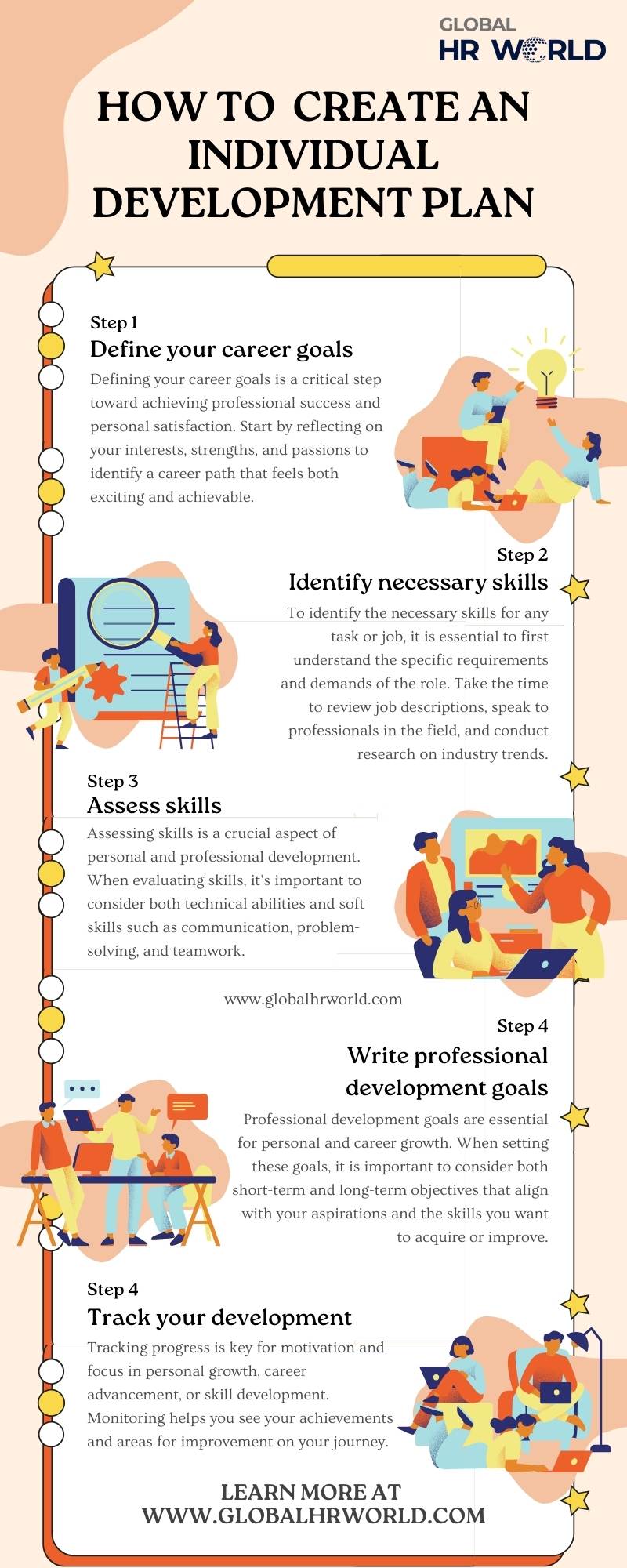In this article, we will discuss why it is important to have an individual development plan to improve employee performance and outline 4 individual development plan examples for maximizing employee productivity.
What is an Individual Development Plan (IDP)?
An individual development plan (IDP) is a personalized document used primarily by employees to set specific career goals and develop a roadmap for achieving them. The plan involves a structured dialogue between an employee and their manager, and it identifies the necessary skills, resources, and training the employee needs to achieve their professional objectives. This helps align their personal goals with the organization’s strategic needs, promoting growth and development within the workplace. Individual development plans (IDPs) usually include:
- Short and long-term career goals the employee wants to achieve
- Current skills are the skills the employee wants to improve, or new ones are needed to learn
- Skills the team leader wants the employee to develop further
- Specific action steps to achieve the career goals (e.g., taking a training course, attending a workshop/seminar, finding a mentor, etc.)
Many different forms of development work well for individual development plans, from PDFs to elaborate e-learning courses. Remember, an individual development plan is a flexible tool. As your career goals and circumstances change, so should your plan. This adaptability is key to taking ownership of career growth and reaching the full potential!
How do Individual Development Plans (IDPs) facilitate employee growth?
Individual development plans are a win-win for everyone, including the organization. IDPs encourage the employees to align their career goals with the organization and co-create a plan to get there. This mutual investment in each other’s growth fosters a sense of value and belonging within the organization.
- Goal setting: Individual development plans are not just about setting goals but about setting specific, measurable, achievable, relevant, and time-bound (SMART) goals. These goals serve as a guiding star, directing employees’ professional paths and focusing their efforts.
- Skill development: Skill development is a vital aspect of individual development plans (IDPs), focusing on enhancing an employee’s abilities and competencies. These plans are tailored to identify the specific skills that an individual requires to develop to achieve their career objectives and to perform their job more effectively.
- Career pathing: IDPs assist employees in understanding potential career paths within the organization and what they need to do to advance. It involves a detailed process that includes, understanding organizational structure, Identifying career objectives, etc.
- Motivation and engagement: Motivation is about helping employees reach their own career goals, while engagement is about helping employees reach the organization’s goals. Motivated employees may reach their own goals, but that doesn’t mean they will help the organization as a whole. By involving employees in the planning and management of their own development, IDPs increase motivation, engagement, and job satisfaction.
- Performance improvement: The ability of an organization to achieve its goals depends largely on employee performance—employees who are fulfilled and productive can be instrumental assets in steering an organization toward success. Despite this, though, many managers find it challenging to motivate employees and improve their performance. As a manager, it’s vital that you purposefully develop workplace structures and supports that can help lead your team to prosper. Regular review and updates of the IDP ensure continuous learning and adaptation, which enhance job performance over time.
What else do you need more?
Individual Development Plan Examples
Creating an individual development plan (IDP) is a great way to set professional goals and outline the steps needed to achieve them. Let’s explore practical individual development plan examples across different professional roles:
Individual development plan examples for leadership
Leadership demands continuous evolution, especially when tasked with guiding cross-functional teams. Enhancing leadership skills can involve a blend of formal education and real-world experience. For example, consider a professional aiming to boost their ability to lead diverse teams effectively.
This journey might begin with attending leadership workshops providing theoretical knowledge and practical strategies for managing varied team dynamics. Complementing this with mentorship from experienced leaders can provide invaluable insights and guidance, offering a personal touch to theoretical learning. Resources like leadership books and online courses can supplement this learning, while internal programs may offer tailored training suited to specific organizational needs. Typically, such a plan would span six months to a year, allowing adequate time for learning, applying, and refining leadership techniques.
Individual development plan examples for career
Transitioning to a new career field, such as moving from sales to marketing, requires a thoughtful approach to skills acquisition and networking. This could involve pursuing certifications relevant to marketing to solidify one’s understanding and credibility in the new field. Networking plays an important role; connecting with industry professionals can provide insights, advice, and potential job leads that are critical during a career shift. Engaging in projects, even on a volunteer or trial basis, can also provide essential hands-on experience and bolster one’s resume in the new field.
Supportive resources such as professional associations offer workshops and seminars that provide both learning opportunities and networking platforms. Career counseling can also guide one through the transition, helping to strategically navigate the new landscape. The timeline for such a transition typically ranges from one to two years, allowing enough time to develop skills, build a network, and gain relevant experience.
Individual development plan examples for managers
For managers, improving team performance and engagement is a common yet complex goal. This improvement might focus on more effective communication and feedback mechanisms, such as implementing regular feedback sessions that not only gauge progress but also foster an open dialogue for issues and successes. Attending management training can help refine a manager’s skills in conflict resolution, motivation, and leadership while developing a team-building program can enhance cohesion and cooperation among team members. Resources like management books and HR support tools can provide foundational knowledge and innovative ideas for team management strategies. Feedback tools specifically designed for team settings can also be instrumental in tracking progress and areas needing improvement.
Infographic

Knowledge Check!
Frequently Asked Questions (FAQs)
Q: What is an Individual Development Plan (IDP)?
A: An individual development plan (IDP) is a personalized document used primarily by employees to set specific career goals and develop a roadmap for achieving them.
Q: What are individual development plan examples?
A: Enhancing leadership skills can involve a blend of formal education and real-world experience. For example, consider a professional aiming to boost their ability to lead diverse teams effectively.



